Workforce Agility: A Key to Sustainable Future for Businesses
VerifiedAdded on 2022/11/23
|7
|2448
|418
AI Summary
This article discusses the importance of workforce agility for businesses to adapt to changes in the work environment. It explains how an agile workforce can help businesses achieve sustainable growth and overcome challenges in the modern-day competitive market. The article also highlights the role of agile teams in managing ethics, designing multivariate teams, and utilizing resources effectively. It concludes that workforce agility is a key to the sustainable future of businesses.
Contribute Materials
Your contribution can guide someone’s learning journey. Share your
documents today.
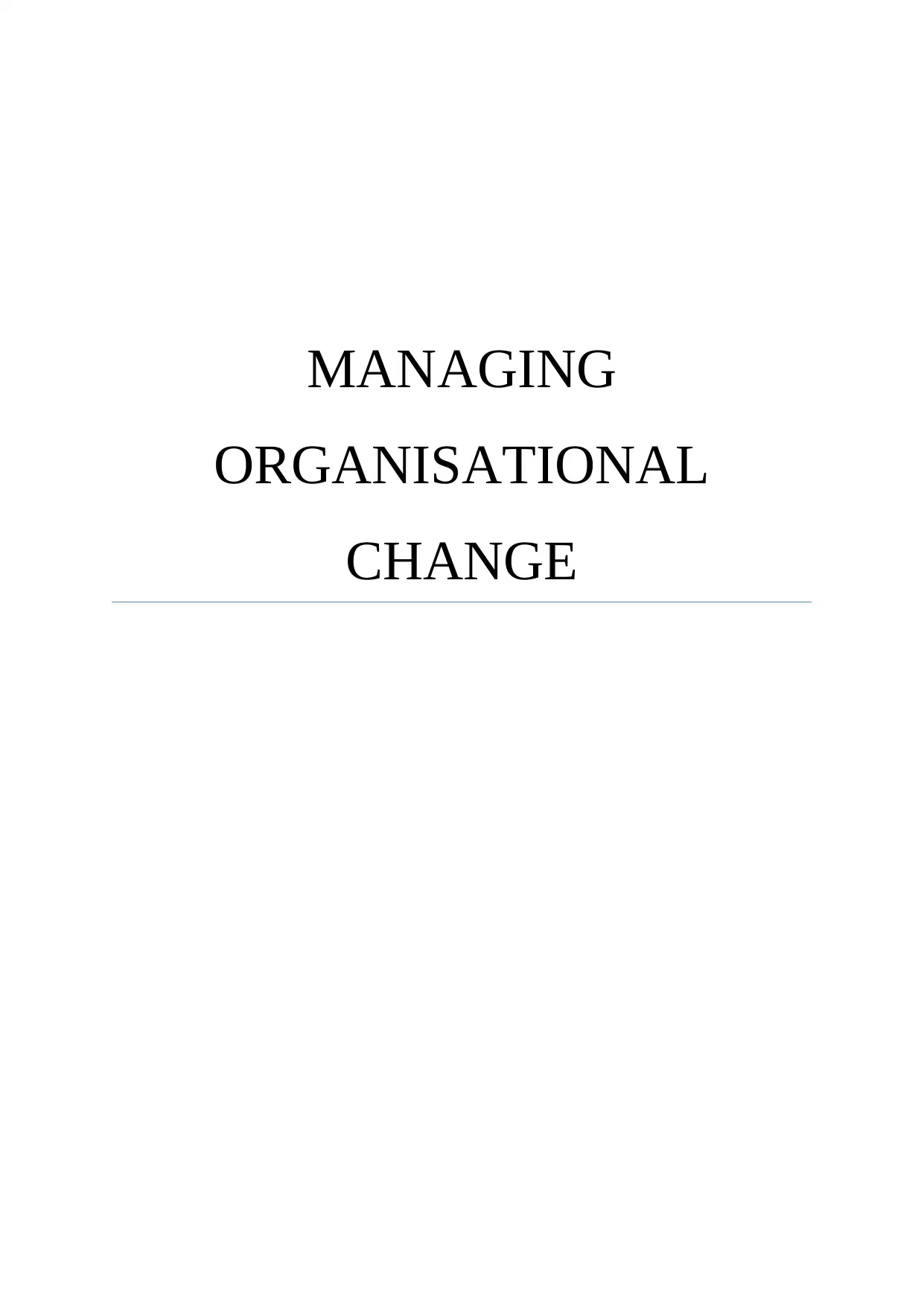
MANAGING
ORGANISATIONAL
CHANGE
ORGANISATIONAL
CHANGE
Secure Best Marks with AI Grader
Need help grading? Try our AI Grader for instant feedback on your assignments.
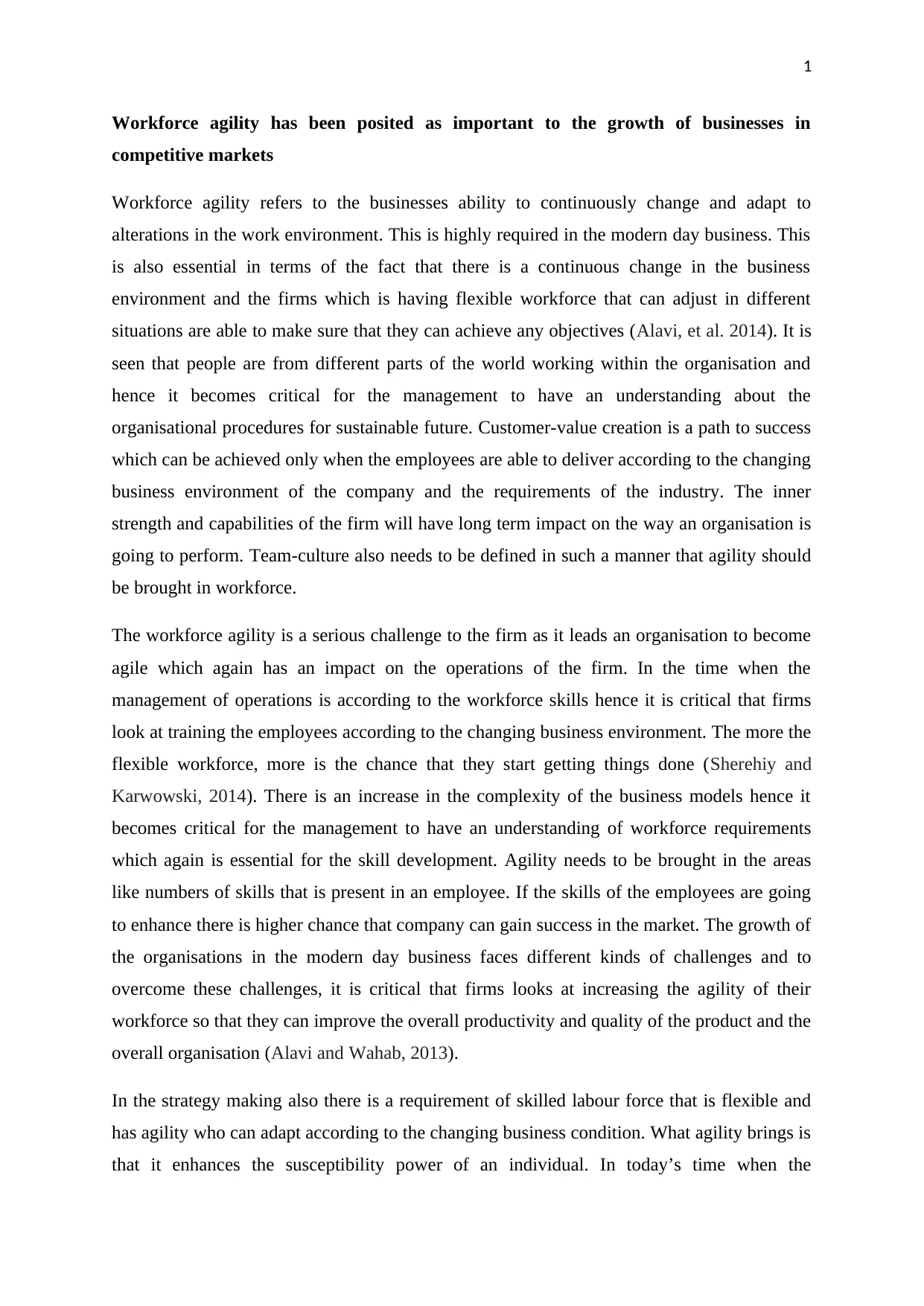
1
Workforce agility has been posited as important to the growth of businesses in
competitive markets
Workforce agility refers to the businesses ability to continuously change and adapt to
alterations in the work environment. This is highly required in the modern day business. This
is also essential in terms of the fact that there is a continuous change in the business
environment and the firms which is having flexible workforce that can adjust in different
situations are able to make sure that they can achieve any objectives (Alavi, et al. 2014). It is
seen that people are from different parts of the world working within the organisation and
hence it becomes critical for the management to have an understanding about the
organisational procedures for sustainable future. Customer-value creation is a path to success
which can be achieved only when the employees are able to deliver according to the changing
business environment of the company and the requirements of the industry. The inner
strength and capabilities of the firm will have long term impact on the way an organisation is
going to perform. Team-culture also needs to be defined in such a manner that agility should
be brought in workforce.
The workforce agility is a serious challenge to the firm as it leads an organisation to become
agile which again has an impact on the operations of the firm. In the time when the
management of operations is according to the workforce skills hence it is critical that firms
look at training the employees according to the changing business environment. The more the
flexible workforce, more is the chance that they start getting things done (Sherehiy and
Karwowski, 2014). There is an increase in the complexity of the business models hence it
becomes critical for the management to have an understanding of workforce requirements
which again is essential for the skill development. Agility needs to be brought in the areas
like numbers of skills that is present in an employee. If the skills of the employees are going
to enhance there is higher chance that company can gain success in the market. The growth of
the organisations in the modern day business faces different kinds of challenges and to
overcome these challenges, it is critical that firms looks at increasing the agility of their
workforce so that they can improve the overall productivity and quality of the product and the
overall organisation (Alavi and Wahab, 2013).
In the strategy making also there is a requirement of skilled labour force that is flexible and
has agility who can adapt according to the changing business condition. What agility brings is
that it enhances the susceptibility power of an individual. In today’s time when the
Workforce agility has been posited as important to the growth of businesses in
competitive markets
Workforce agility refers to the businesses ability to continuously change and adapt to
alterations in the work environment. This is highly required in the modern day business. This
is also essential in terms of the fact that there is a continuous change in the business
environment and the firms which is having flexible workforce that can adjust in different
situations are able to make sure that they can achieve any objectives (Alavi, et al. 2014). It is
seen that people are from different parts of the world working within the organisation and
hence it becomes critical for the management to have an understanding about the
organisational procedures for sustainable future. Customer-value creation is a path to success
which can be achieved only when the employees are able to deliver according to the changing
business environment of the company and the requirements of the industry. The inner
strength and capabilities of the firm will have long term impact on the way an organisation is
going to perform. Team-culture also needs to be defined in such a manner that agility should
be brought in workforce.
The workforce agility is a serious challenge to the firm as it leads an organisation to become
agile which again has an impact on the operations of the firm. In the time when the
management of operations is according to the workforce skills hence it is critical that firms
look at training the employees according to the changing business environment. The more the
flexible workforce, more is the chance that they start getting things done (Sherehiy and
Karwowski, 2014). There is an increase in the complexity of the business models hence it
becomes critical for the management to have an understanding of workforce requirements
which again is essential for the skill development. Agility needs to be brought in the areas
like numbers of skills that is present in an employee. If the skills of the employees are going
to enhance there is higher chance that company can gain success in the market. The growth of
the organisations in the modern day business faces different kinds of challenges and to
overcome these challenges, it is critical that firms looks at increasing the agility of their
workforce so that they can improve the overall productivity and quality of the product and the
overall organisation (Alavi and Wahab, 2013).
In the strategy making also there is a requirement of skilled labour force that is flexible and
has agility who can adapt according to the changing business condition. What agility brings is
that it enhances the susceptibility power of an individual. In today’s time when the
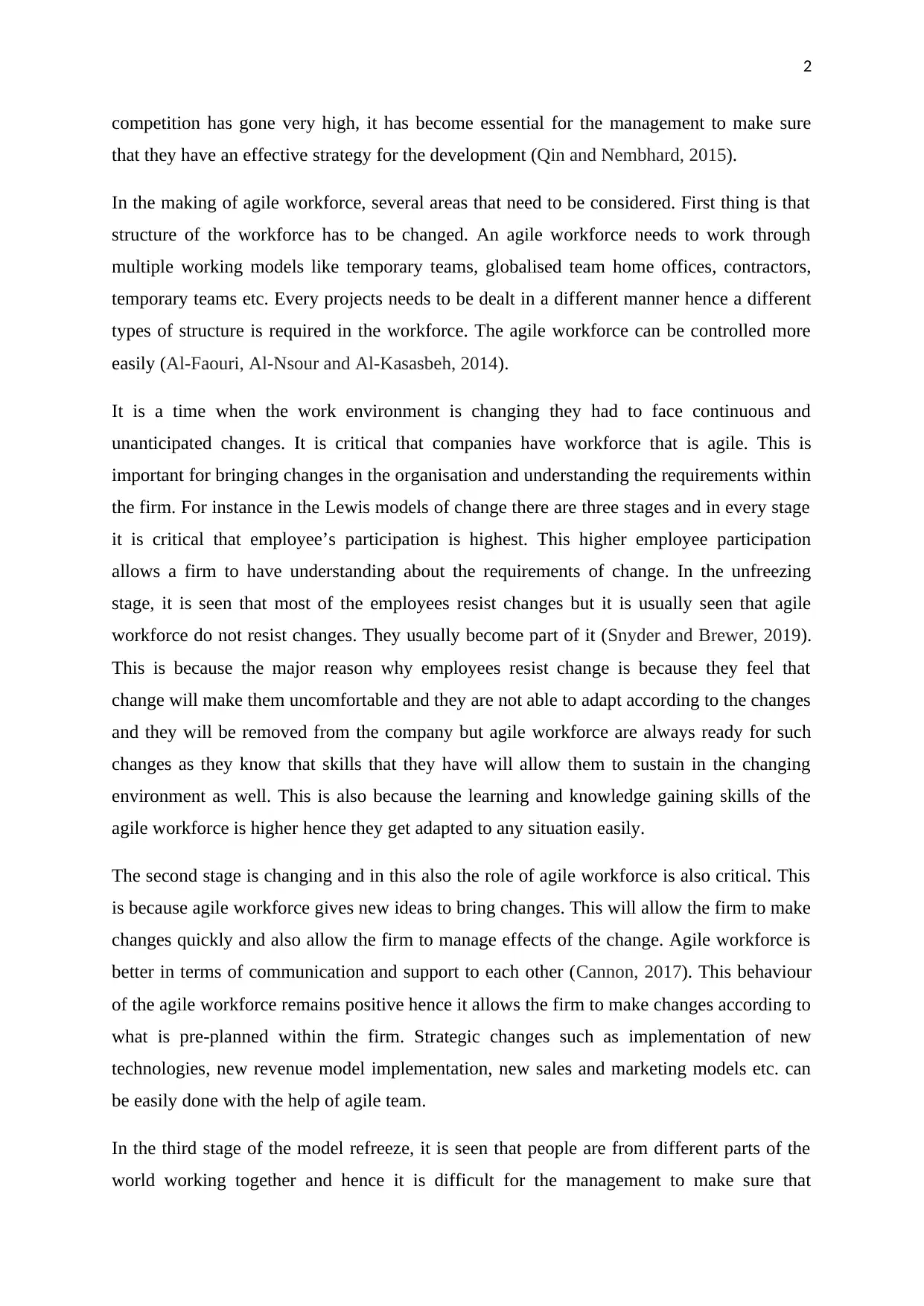
2
competition has gone very high, it has become essential for the management to make sure
that they have an effective strategy for the development (Qin and Nembhard, 2015).
In the making of agile workforce, several areas that need to be considered. First thing is that
structure of the workforce has to be changed. An agile workforce needs to work through
multiple working models like temporary teams, globalised team home offices, contractors,
temporary teams etc. Every projects needs to be dealt in a different manner hence a different
types of structure is required in the workforce. The agile workforce can be controlled more
easily (Al-Faouri, Al-Nsour and Al-Kasasbeh, 2014).
It is a time when the work environment is changing they had to face continuous and
unanticipated changes. It is critical that companies have workforce that is agile. This is
important for bringing changes in the organisation and understanding the requirements within
the firm. For instance in the Lewis models of change there are three stages and in every stage
it is critical that employee’s participation is highest. This higher employee participation
allows a firm to have understanding about the requirements of change. In the unfreezing
stage, it is seen that most of the employees resist changes but it is usually seen that agile
workforce do not resist changes. They usually become part of it (Snyder and Brewer, 2019).
This is because the major reason why employees resist change is because they feel that
change will make them uncomfortable and they are not able to adapt according to the changes
and they will be removed from the company but agile workforce are always ready for such
changes as they know that skills that they have will allow them to sustain in the changing
environment as well. This is also because the learning and knowledge gaining skills of the
agile workforce is higher hence they get adapted to any situation easily.
The second stage is changing and in this also the role of agile workforce is also critical. This
is because agile workforce gives new ideas to bring changes. This will allow the firm to make
changes quickly and also allow the firm to manage effects of the change. Agile workforce is
better in terms of communication and support to each other (Cannon, 2017). This behaviour
of the agile workforce remains positive hence it allows the firm to make changes according to
what is pre-planned within the firm. Strategic changes such as implementation of new
technologies, new revenue model implementation, new sales and marketing models etc. can
be easily done with the help of agile team.
In the third stage of the model refreeze, it is seen that people are from different parts of the
world working together and hence it is difficult for the management to make sure that
competition has gone very high, it has become essential for the management to make sure
that they have an effective strategy for the development (Qin and Nembhard, 2015).
In the making of agile workforce, several areas that need to be considered. First thing is that
structure of the workforce has to be changed. An agile workforce needs to work through
multiple working models like temporary teams, globalised team home offices, contractors,
temporary teams etc. Every projects needs to be dealt in a different manner hence a different
types of structure is required in the workforce. The agile workforce can be controlled more
easily (Al-Faouri, Al-Nsour and Al-Kasasbeh, 2014).
It is a time when the work environment is changing they had to face continuous and
unanticipated changes. It is critical that companies have workforce that is agile. This is
important for bringing changes in the organisation and understanding the requirements within
the firm. For instance in the Lewis models of change there are three stages and in every stage
it is critical that employee’s participation is highest. This higher employee participation
allows a firm to have understanding about the requirements of change. In the unfreezing
stage, it is seen that most of the employees resist changes but it is usually seen that agile
workforce do not resist changes. They usually become part of it (Snyder and Brewer, 2019).
This is because the major reason why employees resist change is because they feel that
change will make them uncomfortable and they are not able to adapt according to the changes
and they will be removed from the company but agile workforce are always ready for such
changes as they know that skills that they have will allow them to sustain in the changing
environment as well. This is also because the learning and knowledge gaining skills of the
agile workforce is higher hence they get adapted to any situation easily.
The second stage is changing and in this also the role of agile workforce is also critical. This
is because agile workforce gives new ideas to bring changes. This will allow the firm to make
changes quickly and also allow the firm to manage effects of the change. Agile workforce is
better in terms of communication and support to each other (Cannon, 2017). This behaviour
of the agile workforce remains positive hence it allows the firm to make changes according to
what is pre-planned within the firm. Strategic changes such as implementation of new
technologies, new revenue model implementation, new sales and marketing models etc. can
be easily done with the help of agile team.
In the third stage of the model refreeze, it is seen that people are from different parts of the
world working together and hence it is difficult for the management to make sure that
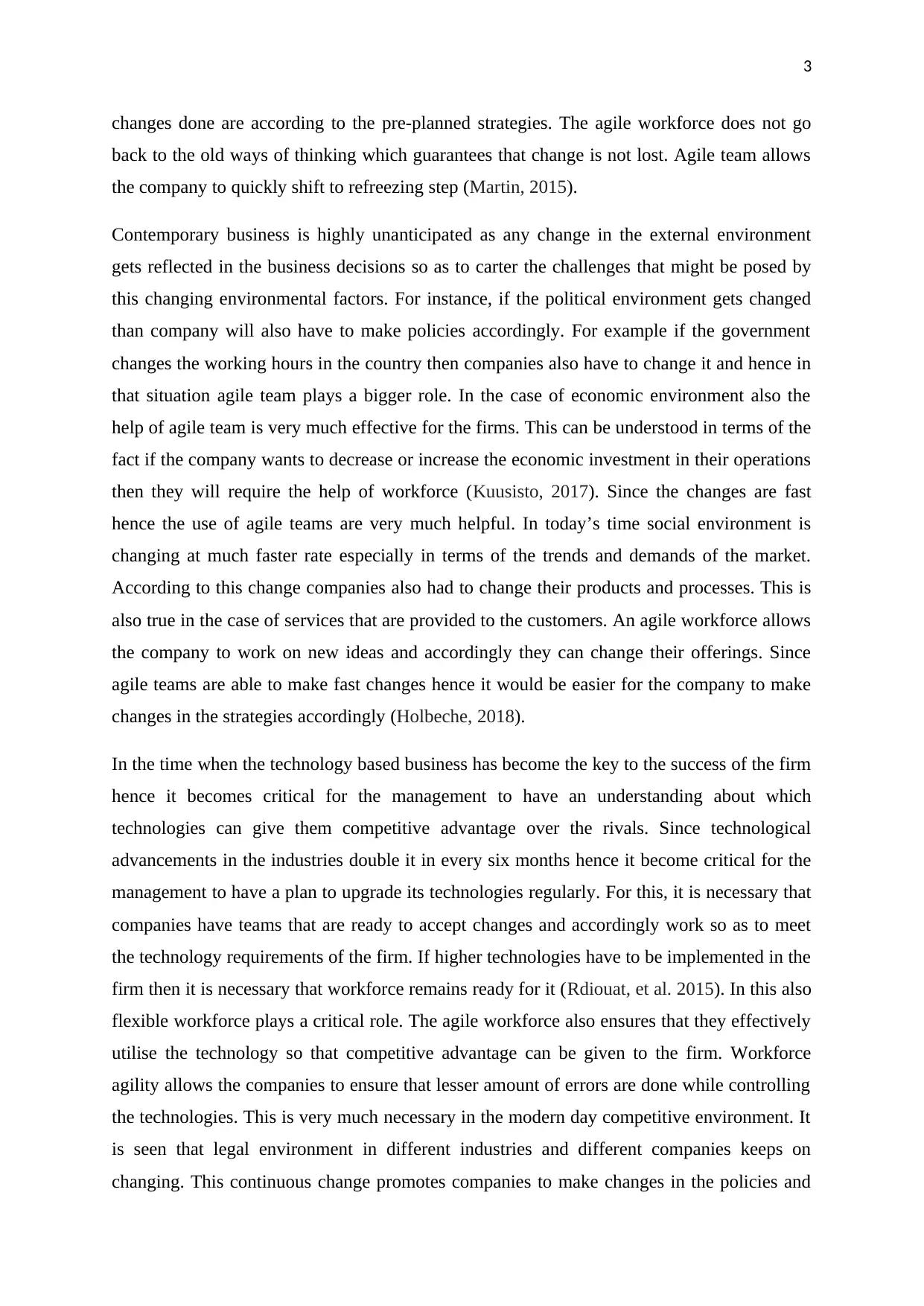
3
changes done are according to the pre-planned strategies. The agile workforce does not go
back to the old ways of thinking which guarantees that change is not lost. Agile team allows
the company to quickly shift to refreezing step (Martin, 2015).
Contemporary business is highly unanticipated as any change in the external environment
gets reflected in the business decisions so as to carter the challenges that might be posed by
this changing environmental factors. For instance, if the political environment gets changed
than company will also have to make policies accordingly. For example if the government
changes the working hours in the country then companies also have to change it and hence in
that situation agile team plays a bigger role. In the case of economic environment also the
help of agile team is very much effective for the firms. This can be understood in terms of the
fact if the company wants to decrease or increase the economic investment in their operations
then they will require the help of workforce (Kuusisto, 2017). Since the changes are fast
hence the use of agile teams are very much helpful. In today’s time social environment is
changing at much faster rate especially in terms of the trends and demands of the market.
According to this change companies also had to change their products and processes. This is
also true in the case of services that are provided to the customers. An agile workforce allows
the company to work on new ideas and accordingly they can change their offerings. Since
agile teams are able to make fast changes hence it would be easier for the company to make
changes in the strategies accordingly (Holbeche, 2018).
In the time when the technology based business has become the key to the success of the firm
hence it becomes critical for the management to have an understanding about which
technologies can give them competitive advantage over the rivals. Since technological
advancements in the industries double it in every six months hence it become critical for the
management to have a plan to upgrade its technologies regularly. For this, it is necessary that
companies have teams that are ready to accept changes and accordingly work so as to meet
the technology requirements of the firm. If higher technologies have to be implemented in the
firm then it is necessary that workforce remains ready for it (Rdiouat, et al. 2015). In this also
flexible workforce plays a critical role. The agile workforce also ensures that they effectively
utilise the technology so that competitive advantage can be given to the firm. Workforce
agility allows the companies to ensure that lesser amount of errors are done while controlling
the technologies. This is very much necessary in the modern day competitive environment. It
is seen that legal environment in different industries and different companies keeps on
changing. This continuous change promotes companies to make changes in the policies and
changes done are according to the pre-planned strategies. The agile workforce does not go
back to the old ways of thinking which guarantees that change is not lost. Agile team allows
the company to quickly shift to refreezing step (Martin, 2015).
Contemporary business is highly unanticipated as any change in the external environment
gets reflected in the business decisions so as to carter the challenges that might be posed by
this changing environmental factors. For instance, if the political environment gets changed
than company will also have to make policies accordingly. For example if the government
changes the working hours in the country then companies also have to change it and hence in
that situation agile team plays a bigger role. In the case of economic environment also the
help of agile team is very much effective for the firms. This can be understood in terms of the
fact if the company wants to decrease or increase the economic investment in their operations
then they will require the help of workforce (Kuusisto, 2017). Since the changes are fast
hence the use of agile teams are very much helpful. In today’s time social environment is
changing at much faster rate especially in terms of the trends and demands of the market.
According to this change companies also had to change their products and processes. This is
also true in the case of services that are provided to the customers. An agile workforce allows
the company to work on new ideas and accordingly they can change their offerings. Since
agile teams are able to make fast changes hence it would be easier for the company to make
changes in the strategies accordingly (Holbeche, 2018).
In the time when the technology based business has become the key to the success of the firm
hence it becomes critical for the management to have an understanding about which
technologies can give them competitive advantage over the rivals. Since technological
advancements in the industries double it in every six months hence it become critical for the
management to have a plan to upgrade its technologies regularly. For this, it is necessary that
companies have teams that are ready to accept changes and accordingly work so as to meet
the technology requirements of the firm. If higher technologies have to be implemented in the
firm then it is necessary that workforce remains ready for it (Rdiouat, et al. 2015). In this also
flexible workforce plays a critical role. The agile workforce also ensures that they effectively
utilise the technology so that competitive advantage can be given to the firm. Workforce
agility allows the companies to ensure that lesser amount of errors are done while controlling
the technologies. This is very much necessary in the modern day competitive environment. It
is seen that legal environment in different industries and different companies keeps on
changing. This continuous change promotes companies to make changes in the policies and
Secure Best Marks with AI Grader
Need help grading? Try our AI Grader for instant feedback on your assignments.
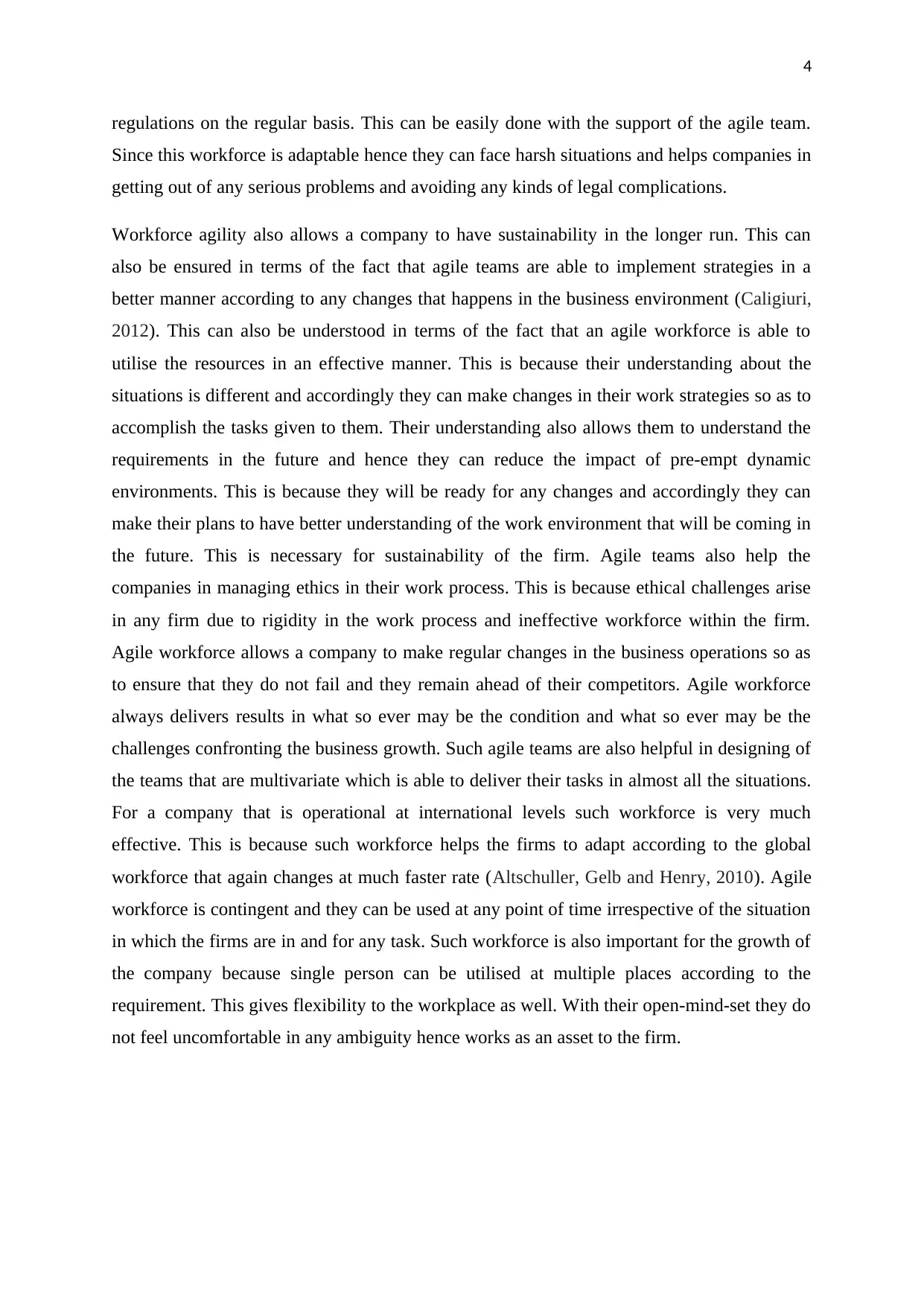
4
regulations on the regular basis. This can be easily done with the support of the agile team.
Since this workforce is adaptable hence they can face harsh situations and helps companies in
getting out of any serious problems and avoiding any kinds of legal complications.
Workforce agility also allows a company to have sustainability in the longer run. This can
also be ensured in terms of the fact that agile teams are able to implement strategies in a
better manner according to any changes that happens in the business environment (Caligiuri,
2012). This can also be understood in terms of the fact that an agile workforce is able to
utilise the resources in an effective manner. This is because their understanding about the
situations is different and accordingly they can make changes in their work strategies so as to
accomplish the tasks given to them. Their understanding also allows them to understand the
requirements in the future and hence they can reduce the impact of pre-empt dynamic
environments. This is because they will be ready for any changes and accordingly they can
make their plans to have better understanding of the work environment that will be coming in
the future. This is necessary for sustainability of the firm. Agile teams also help the
companies in managing ethics in their work process. This is because ethical challenges arise
in any firm due to rigidity in the work process and ineffective workforce within the firm.
Agile workforce allows a company to make regular changes in the business operations so as
to ensure that they do not fail and they remain ahead of their competitors. Agile workforce
always delivers results in what so ever may be the condition and what so ever may be the
challenges confronting the business growth. Such agile teams are also helpful in designing of
the teams that are multivariate which is able to deliver their tasks in almost all the situations.
For a company that is operational at international levels such workforce is very much
effective. This is because such workforce helps the firms to adapt according to the global
workforce that again changes at much faster rate (Altschuller, Gelb and Henry, 2010). Agile
workforce is contingent and they can be used at any point of time irrespective of the situation
in which the firms are in and for any task. Such workforce is also important for the growth of
the company because single person can be utilised at multiple places according to the
requirement. This gives flexibility to the workplace as well. With their open-mind-set they do
not feel uncomfortable in any ambiguity hence works as an asset to the firm.
regulations on the regular basis. This can be easily done with the support of the agile team.
Since this workforce is adaptable hence they can face harsh situations and helps companies in
getting out of any serious problems and avoiding any kinds of legal complications.
Workforce agility also allows a company to have sustainability in the longer run. This can
also be ensured in terms of the fact that agile teams are able to implement strategies in a
better manner according to any changes that happens in the business environment (Caligiuri,
2012). This can also be understood in terms of the fact that an agile workforce is able to
utilise the resources in an effective manner. This is because their understanding about the
situations is different and accordingly they can make changes in their work strategies so as to
accomplish the tasks given to them. Their understanding also allows them to understand the
requirements in the future and hence they can reduce the impact of pre-empt dynamic
environments. This is because they will be ready for any changes and accordingly they can
make their plans to have better understanding of the work environment that will be coming in
the future. This is necessary for sustainability of the firm. Agile teams also help the
companies in managing ethics in their work process. This is because ethical challenges arise
in any firm due to rigidity in the work process and ineffective workforce within the firm.
Agile workforce allows a company to make regular changes in the business operations so as
to ensure that they do not fail and they remain ahead of their competitors. Agile workforce
always delivers results in what so ever may be the condition and what so ever may be the
challenges confronting the business growth. Such agile teams are also helpful in designing of
the teams that are multivariate which is able to deliver their tasks in almost all the situations.
For a company that is operational at international levels such workforce is very much
effective. This is because such workforce helps the firms to adapt according to the global
workforce that again changes at much faster rate (Altschuller, Gelb and Henry, 2010). Agile
workforce is contingent and they can be used at any point of time irrespective of the situation
in which the firms are in and for any task. Such workforce is also important for the growth of
the company because single person can be utilised at multiple places according to the
requirement. This gives flexibility to the workplace as well. With their open-mind-set they do
not feel uncomfortable in any ambiguity hence works as an asset to the firm.
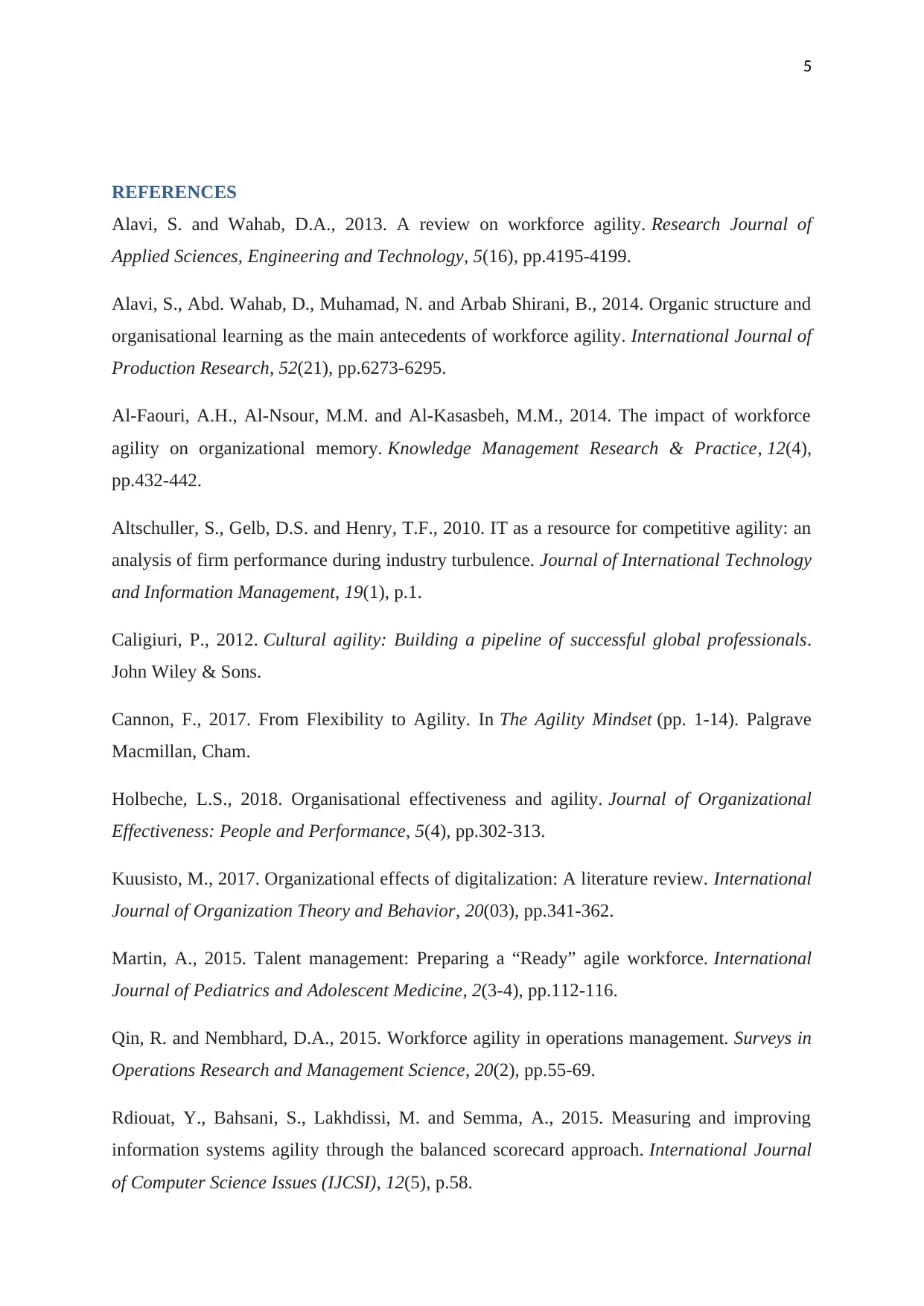
5
REFERENCES
Alavi, S. and Wahab, D.A., 2013. A review on workforce agility. Research Journal of
Applied Sciences, Engineering and Technology, 5(16), pp.4195-4199.
Alavi, S., Abd. Wahab, D., Muhamad, N. and Arbab Shirani, B., 2014. Organic structure and
organisational learning as the main antecedents of workforce agility. International Journal of
Production Research, 52(21), pp.6273-6295.
Al-Faouri, A.H., Al-Nsour, M.M. and Al-Kasasbeh, M.M., 2014. The impact of workforce
agility on organizational memory. Knowledge Management Research & Practice, 12(4),
pp.432-442.
Altschuller, S., Gelb, D.S. and Henry, T.F., 2010. IT as a resource for competitive agility: an
analysis of firm performance during industry turbulence. Journal of International Technology
and Information Management, 19(1), p.1.
Caligiuri, P., 2012. Cultural agility: Building a pipeline of successful global professionals.
John Wiley & Sons.
Cannon, F., 2017. From Flexibility to Agility. In The Agility Mindset (pp. 1-14). Palgrave
Macmillan, Cham.
Holbeche, L.S., 2018. Organisational effectiveness and agility. Journal of Organizational
Effectiveness: People and Performance, 5(4), pp.302-313.
Kuusisto, M., 2017. Organizational effects of digitalization: A literature review. International
Journal of Organization Theory and Behavior, 20(03), pp.341-362.
Martin, A., 2015. Talent management: Preparing a “Ready” agile workforce. International
Journal of Pediatrics and Adolescent Medicine, 2(3-4), pp.112-116.
Qin, R. and Nembhard, D.A., 2015. Workforce agility in operations management. Surveys in
Operations Research and Management Science, 20(2), pp.55-69.
Rdiouat, Y., Bahsani, S., Lakhdissi, M. and Semma, A., 2015. Measuring and improving
information systems agility through the balanced scorecard approach. International Journal
of Computer Science Issues (IJCSI), 12(5), p.58.
REFERENCES
Alavi, S. and Wahab, D.A., 2013. A review on workforce agility. Research Journal of
Applied Sciences, Engineering and Technology, 5(16), pp.4195-4199.
Alavi, S., Abd. Wahab, D., Muhamad, N. and Arbab Shirani, B., 2014. Organic structure and
organisational learning as the main antecedents of workforce agility. International Journal of
Production Research, 52(21), pp.6273-6295.
Al-Faouri, A.H., Al-Nsour, M.M. and Al-Kasasbeh, M.M., 2014. The impact of workforce
agility on organizational memory. Knowledge Management Research & Practice, 12(4),
pp.432-442.
Altschuller, S., Gelb, D.S. and Henry, T.F., 2010. IT as a resource for competitive agility: an
analysis of firm performance during industry turbulence. Journal of International Technology
and Information Management, 19(1), p.1.
Caligiuri, P., 2012. Cultural agility: Building a pipeline of successful global professionals.
John Wiley & Sons.
Cannon, F., 2017. From Flexibility to Agility. In The Agility Mindset (pp. 1-14). Palgrave
Macmillan, Cham.
Holbeche, L.S., 2018. Organisational effectiveness and agility. Journal of Organizational
Effectiveness: People and Performance, 5(4), pp.302-313.
Kuusisto, M., 2017. Organizational effects of digitalization: A literature review. International
Journal of Organization Theory and Behavior, 20(03), pp.341-362.
Martin, A., 2015. Talent management: Preparing a “Ready” agile workforce. International
Journal of Pediatrics and Adolescent Medicine, 2(3-4), pp.112-116.
Qin, R. and Nembhard, D.A., 2015. Workforce agility in operations management. Surveys in
Operations Research and Management Science, 20(2), pp.55-69.
Rdiouat, Y., Bahsani, S., Lakhdissi, M. and Semma, A., 2015. Measuring and improving
information systems agility through the balanced scorecard approach. International Journal
of Computer Science Issues (IJCSI), 12(5), p.58.
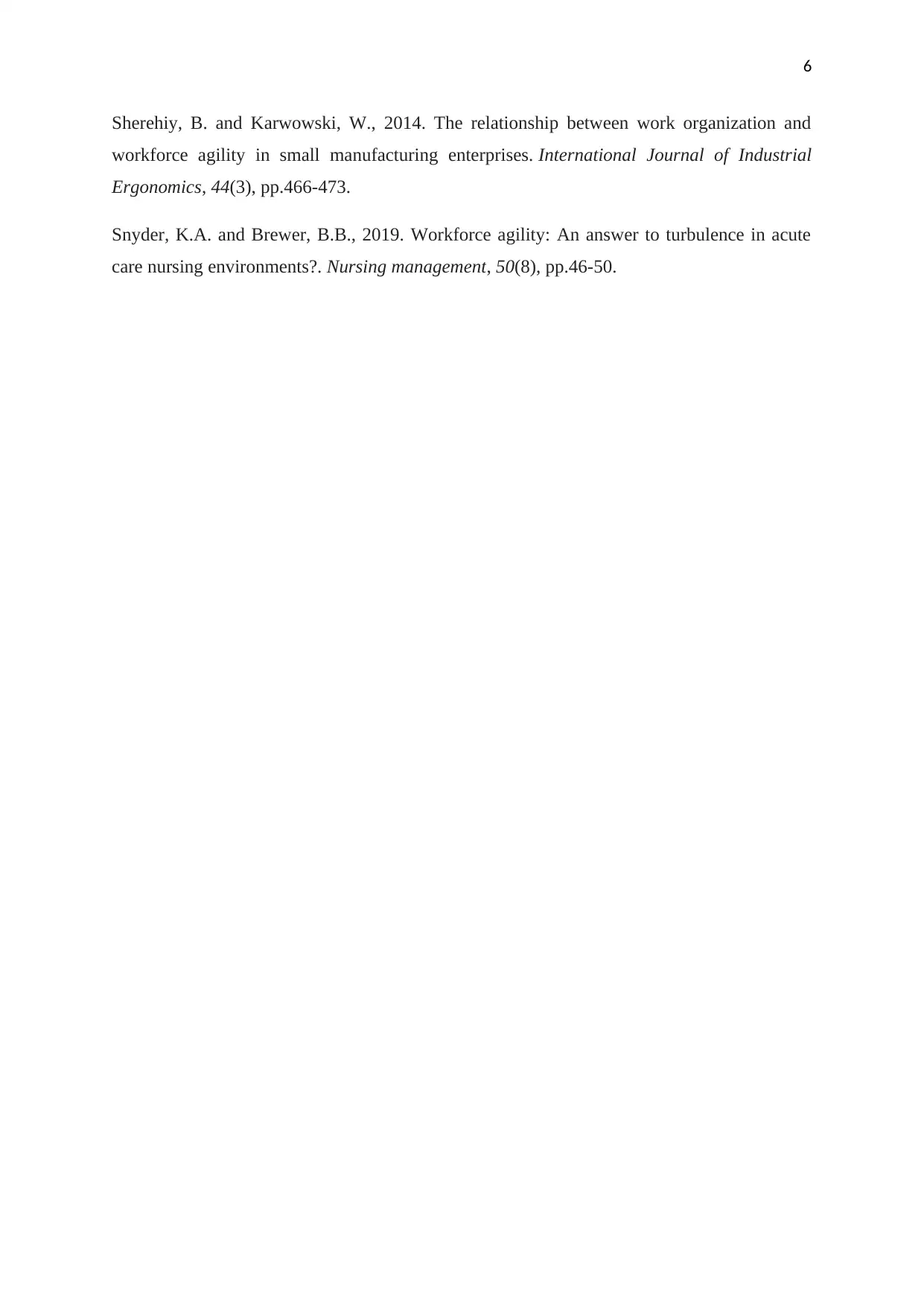
6
Sherehiy, B. and Karwowski, W., 2014. The relationship between work organization and
workforce agility in small manufacturing enterprises. International Journal of Industrial
Ergonomics, 44(3), pp.466-473.
Snyder, K.A. and Brewer, B.B., 2019. Workforce agility: An answer to turbulence in acute
care nursing environments?. Nursing management, 50(8), pp.46-50.
Sherehiy, B. and Karwowski, W., 2014. The relationship between work organization and
workforce agility in small manufacturing enterprises. International Journal of Industrial
Ergonomics, 44(3), pp.466-473.
Snyder, K.A. and Brewer, B.B., 2019. Workforce agility: An answer to turbulence in acute
care nursing environments?. Nursing management, 50(8), pp.46-50.
1 out of 7
Related Documents
Your All-in-One AI-Powered Toolkit for Academic Success.
+13062052269
info@desklib.com
Available 24*7 on WhatsApp / Email
![[object Object]](/_next/static/media/star-bottom.7253800d.svg)
Unlock your academic potential
© 2024 | Zucol Services PVT LTD | All rights reserved.





